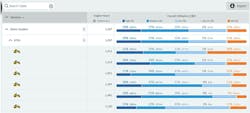Set a Baseline for Operator Coaching
Equipment operators literally hold the keys to a fleet’s production, lifecycle, and operating cost performance. Machine technology and machine data offer opportunities for equipment managers to coach their operators to not only ensure that operations are efficient, but also to equip operators to be the best at what they do.
John Deere’s JDLink can help set the benchmarks for operator behavior that allow effective coaching to improve performance across a fleet, says James Leibold, product marketing manager for Connected Solutions.
How to use telematics for operator and driver coaching
- Machine data changes operator behavior
- How to use telematics to reduce insurance costs
- How video, AI improve operator safety
- How to use fault codes to improve operator performance
- Three ways data leads to coaching opportunities
- Fleets more adept at using machine data
- Data encourages operator coaching
“It’s important for customers to understand the micro to macro level of data you can get within JDLink,” he says. “If you have operators in 100 different loaders, you can use this to compare operators against each other, to set a baseline...[to determine] who might need some coaching.”
A JDLink report called “Machine Analyzer” can output machine data by machine type or even by size class within type.
“You can choose the data points,” Leibold says. “If you want to see how much fuel is consumed, the engine utilization, or if Eco Mode is being used by your operators, [it can be displayed]. [You] can look at [your] grade control usage across all [your] operators. If [a fleet] invested in grade control, [it wants] to make sure [operators] are actually using it.”
All of Deere’s dealers have invested in telematics departments and staffed them with experts in machine monitoring and grade control, Leibold says, and they will help equipment managers with data and coaching.
The dealer can work with operators to help them read the monitor and learn where their blade tip is, he says, or how to use offsets on the company’s SmartGrade controls.
“Then they can view the telematics site and look at all the operators’ data and start picking out who might need some coaching.”
Leibold says running numbers for a specific machine type enables a fleet to set a performance baseline, a metric that can be used to identify operators who would benefit from coaching.
“You might have certain operators that complain [that a] machine uses a lot of fuel, or that it’s a rough-riding machine,” he says. “You can use [data] to see which operators are using Eco Mode. They could be using a lot of fuel because they are constantly running in high idle, but they’re not being as productive as they could be. If they used Eco Mode, they would be able to see fuel savings.
“You can say the same about an operator who says the machine rides too rough. You can use the telematics data to say, ‘Out of the 100 hours this machine’s been running, you’ve only had ride control on for two or three hours.’ Show them to coach them: ‘If you simply hit this button that turns on ride control, it is going to make your life easier. It’s going to help you be more productive as if you were a more experienced operator.’
“If we can identify where an operator needs to be trained, it makes their life and job so much easier,” he says.
The baseline also identifies operators who could coach, whose metrics show they are doing everything well. Peer coaching can reduce the sense of wrong-doing and concerns of under-performing from the operator being coached.
